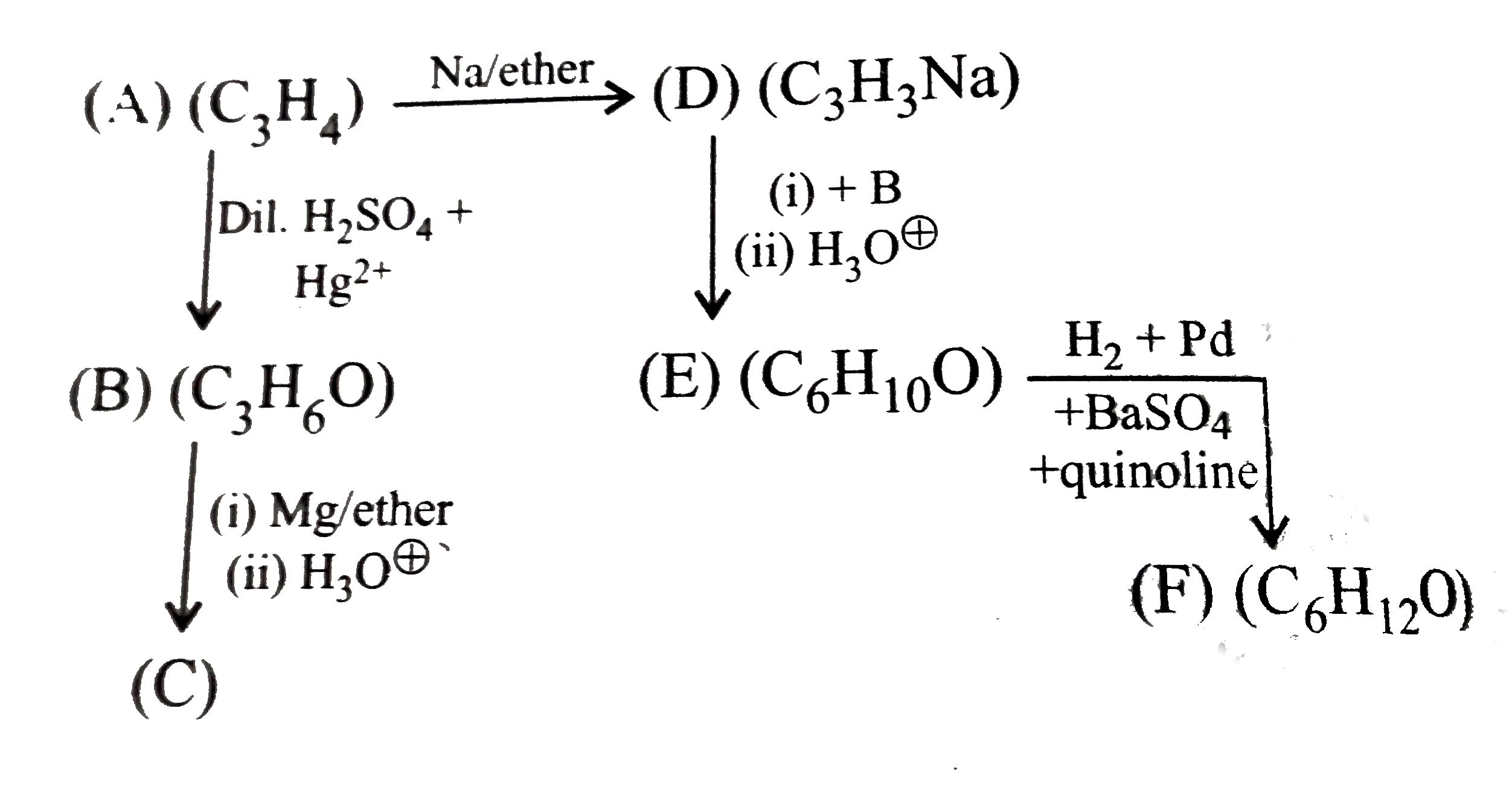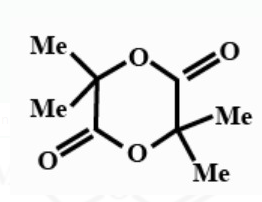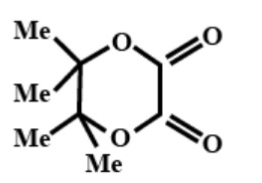An organic compound A (C3H5N) on boiling with alkali gives ammonia and sodium salt of an acid B (C3H6O2). A on reduction gives C(C3H9N) which with nitrous acid gives D (C3H8O). Give the structural formulae of A, B, C and D.
To solve the problem, we need to identify the structures of the organic compounds A, B, C, and D based on the given information. Let's break down the steps:
Step 1: Identify Compound A (C₃H₅N)
The molecular formula C₃H₅N suggests that compound A is likely a primary amine or an imine. Given that it reacts with alkali to produce ammonia, it is reasonable to assume that A is an amine.
Structure of A:
- A can be identified as propylamine (CH₃-CH₂-CH₂-NH₂) or an analogous compound.
- However, considering the reaction with alkali gives ammonia, we can deduce that A is likely to be an amino acid or an amine with a carboxylic acid group.
Final structure of A:
- A = CH₃-CH₂-CH(NH₂)-COOH (which is 3-aminopropanoic acid).
Step 2: Identify Compound B (C₃H₆O₂)
When compound A is boiled with alkali, it produces ammonia and a sodium salt of an acid B. The molecular formula C₃H₆O₂ indicates that B is a carboxylic acid.
Structure of B:
- B can be identified as propanoic acid (CH₃-CH₂-COOH).
Step 3: Reduction of A to form C (C₃H₉N)
When A is reduced, it produces compound C with the formula C₃H₉N. This suggests that the amine group is retained and that the carboxylic acid group is reduced to an alcohol or removed.
Structure of C:
- C can be identified as propylamine (CH₃-CH₂-CH₂-NH₂).
Step 4: Reaction of C with Nitrous Acid to form D (C₃H₈O)
When compound C reacts with nitrous acid (HNO₂), it forms compound D. The molecular formula C₃H₈O suggests that D is an alcohol.
Structure of D:
- D can be identified as propanol (CH₃-CH₂-CH₂-OH).
Summary of Structures:
- A (C₃H₅N): CH₃-CH₂-CH(NH₂)-COOH (3-aminopropanoic acid)
- B (C₃H₆O₂): CH₃-CH₂-COOH (propanoic acid)
- C (C₃H₉N): CH₃-CH₂-CH₂-NH₂ (propylamine)
- D (C₃H₈O): CH₃-CH₂-CH₂-OH (propanol)
The molecular formula C₃H₅N suggests that compound A is likely a primary amine or an imine. Given that it reacts with alkali to produce ammonia, it is reasonable to assume that A is an amine.
- A can be identified as propylamine (CH₃-CH₂-CH₂-NH₂) or an analogous compound.
- However, considering the reaction with alkali gives ammonia, we can deduce that A is likely to be an amino acid or an amine with a carboxylic acid group.
- A = CH₃-CH₂-CH(NH₂)-COOH (which is 3-aminopropanoic acid).
When compound A is boiled with alkali, it produces ammonia and a sodium salt of an acid B. The molecular formula C₃H₆O₂ indicates that B is a carboxylic acid.
- B can be identified as propanoic acid (CH₃-CH₂-COOH).
When A is reduced, it produces compound C with the formula C₃H₉N. This suggests that the amine group is retained and that the carboxylic acid group is reduced to an alcohol or removed.
- C can be identified as propylamine (CH₃-CH₂-CH₂-NH₂).
When compound C reacts with nitrous acid (HNO₂), it forms compound D. The molecular formula C₃H₈O suggests that D is an alcohol.
- D can be identified as propanol (CH₃-CH₂-CH₂-OH).
- A (C₃H₅N): CH₃-CH₂-CH(NH₂)-COOH (3-aminopropanoic acid)
- B (C₃H₆O₂): CH₃-CH₂-COOH (propanoic acid)
- C (C₃H₉N): CH₃-CH₂-CH₂-NH₂ (propylamine)
- D (C₃H₈O): CH₃-CH₂-CH₂-OH (propanol)
Topper's Solved these Questions
- ORGANIC COMPOUNDS CONTAINING NITROGEN BOOK - MODERN PUBLICATIONCHAPTER - ORGANIC COMPOUNDS CONTAINING NITROGEN EXERCISE - Competition File (OBJECTIVE TYPE QUESTIONS) (MULTIPLE CHOICE QUESTIONS (M.C.Q)) (A)
30 Videos
- ORGANIC COMPOUNDS CONTAINING NITROGEN BOOK - MODERN PUBLICATIONCHAPTER - ORGANIC COMPOUNDS CONTAINING NITROGEN EXERCISE - Competition File (B) MULTIPLE CHOICE QUESTIONS
70 Videos
- ORGANIC COMPOUNDS CONTAINING NITROGEN BOOK - MODERN PUBLICATIONCHAPTER - ORGANIC COMPOUNDS CONTAINING NITROGEN EXERCISE - REVISION EXERCISES LONG ANSWER QUESTIONS
5 Videos
- HALOALKANES AND HALOARENESBOOK - MODERN PUBLICATIONCHAPTER - HALOALKANES AND HALOARENESEXERCISE - UNIT PRACTICE TEST
11 Videos
- POLYMERSBOOK - MODERN PUBLICATIONCHAPTER - POLYMERSEXERCISE - Competition file (OBJECTIVE TYPE QUESTIONS) (C. MULTIPLE CHOICE QUESTIONS)(Integer Type Questions)
6 Videos
Similar Questions
An organic compound A (C4H10O) reacts with HI giving a compound B (C4H9I) which on reduction gives n-butane. Oxidation of compound A gives C (C4H8O) and then an acid D (C4H8O2) . Deduce the structure of A,B,C and D.
View SolutionAn organic compound A (C7H6Cl2) on treatment with NaOH solution gives another compound B (C7H6O). B on oxidation gives and acid C (C7H6O2) which on treatment with a mixture of conc. HNO3 and H2SO4 gives a compound D (C7H5NO4). B on treatment with conc. NaOH gives a compound E (C7H8O) and C6H5COONa. Deduce the structures of [A], [B], [C], [D] and [E].
View Solution
Knowledge Check
An organic liquid of the composition C4H8O2 yields a sodium salt of an acid C3H6O2 and methanol on boiling with NaOH solution. The given liqud is
ACH3CH2COOCH3BCH3COOC2H5CHCOOC3H7DCH3CH2CH2COOH
The compound F(C6H12O) on oxidative ozonolysis yirlds acetic acid and a compound (G) (C4H8O3). The new compound (G) on heating gives:A BMe−CH=C=CH−EtC
BMe−CH=C=CH−EtC D
D
An organic compound A(C3H6O)is resistant to oxidation but forms compound B(C3H8O) on reduction which reacts with HBr to form the bromide (C). C forms a Grignard reagent which reacts with A to give D(C6H14O). Give the structures of A, B, C and D and explain the reactions involved.
View SolutionAn organic compound A(C4H8N2) on hydrolysis in acidic medium gives another compound B(C4H9O2N). B forms zwitter ion and gives off CO2 with NaHCO3. B on heating gives compound C(CH4H7ON).LiAlH4 in ether reduces C to pyrolidine. Identify compounds A,B,C.
View SolutionCompound A (C3H9N) reacts with benzene sulphonyl chloride to form a solid insoluble in alkali. The structure of compound A is
View SolutionAn organic compound C8H10 (A) on treatment with alkaline KMnO4 gives a compound C6H6O4. (B) which on strong heating gives C6H4O3 (C). The compound (D) in dry benzene in presen of AlCl3 gives compound (E). The compound (E) on treatment with PCl5 followed by reaction with H2/Pd,BaSO4 gives compound (F). Identify (A) to (F).
View SolutionAn organic compound (A) , C_(8)H_(10)O. The compound (B) upon treatment of alkaline solution of iodine gives a yellow precipitate. The filtrate. The filtrate on acidification gives a while solid ("C") , C7H6O2. Give structures of A, B, C and explain the reactions involved.
View SolutionAn organci compound C6H4O2NCl(A) reacts with a,la,oo tp gove C6H5O3N(B). On reduction with tin and HCl,(B) gives C6H7ON(C) whereas on milder reduction it gives (D)C6H7O2N, which rearranges in the presence of a mineral acid to give a new compound (E). Identify the various compounds from (A), to (E).
View Solution
